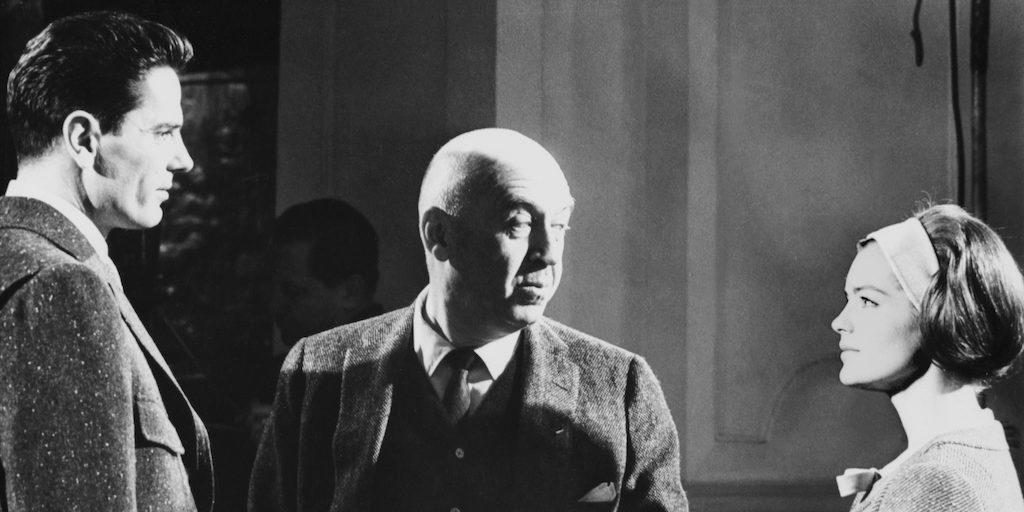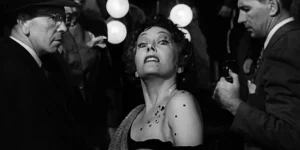Emilia Pérez is a bizarre film, yet extraordinary in every sense. First, its French director, Jacques Audiard, had visited Mexico for the first time 42 years earlier and was captivated and enamored by its culture, but above all by its playful spirit (with its kermeses, fairs, and bullrings) and, at the same time, by the cult of death that Mexicans carry like a part of their DNA since pre-Columbian times. That’s why he decided to pay homage to that exotic world he had experienced and promised himself he wouldn’t forget.
The story was taken from a secondary character in Boris Razon’s novel, “Écoute,” a drug trafficker named Le Flaco (The Skinny One) who wanted to change his sex. Since he wasn’t developed in the story, he decided to give him a chance to resurrect himself.
At first, Audiard thought about making an opera out of that material, perhaps in the style of Bertolt Brecht’s “The Threepenny Opera,” a groundbreaking work for its time that knew how to combine and articulate humor, music, and criticism of a decadent society.
Emilia Pérez de Audiard possesses all the ingredients of Brecht’s play, but in a different world in the sense that at that time, transitioning (changing sex) wasn’t yet discussed, and drug traffickers weren’t at their peak. There was another type of bandit: the beggars organized into brotherhoods.
Emilia Pérez‘s film is also groundbreaking, as it can’t be connected to the structures of a musical comedy, because it isn’t one. It has a touch of the latter and is also linked to the grotesque genre, as its characters are, to a certain extent, grotesque. It also critiques a society whose values are distorted and decadent.
The story could be seen as a melodrama, but it isn’t, which is why the filmic hybrid achieved by Jacques Audiard is so wonderful. Similar to “The Threepenny Opera,” its protagonist escapes death through a “deus ex machina” (the work of God), in this case through a surgeon who transforms him from a man into a woman.
Jacques Audiard had made his English debut with The Sister Brothers, winner of the Golden Lion at the Venice Film Festival, then the Palme d’Or at Cannes for Dheepan, and was most internationally recognized for his Oscar-nominated film, Un prophète.
Although his narrative encompasses several genres, in the case of Emilia Pérez, it is based on redemption, which comes about through the extreme sacrifice of its protagonist, who seeks a total transformation, although the viewer is not entirely sure why, whether because he truly wants to be a woman or because he wants to escape death or prison. Audiard deconstructs his characters with singular mastery until they reach a point from which they cannot return, and then builds their lives with a new destiny.
What’s interesting about Audiard is that he’s an expert at weaving a combination of tones, genres, and compelling themes into a canvas, as in the case of Emilia Pérez. Frame by frame in this film, not only the images change, but also the colors, the architecture of the scene, and the point of view, which always shifts toward opposite spaces, creating a crazy transition between sequences.
The curious thing about this film, shot entirely in studios and locations in Paris, is that he managed to create a Mexican atmosphere, both in the playful sense and in the sense of the violence generated by the drug cartels, whose power increases every year and which generates multiple disappearances of people, whether they belong to another cartel or innocent victims whom chance puts in their path, or women sold to pimps. In it, one can find the flavor and spirit of that Mexico that combines the indigenous spirit of the natives with the mischievousness of the mixed race and the insolence of the white man.
Emilia Pérez‘s plot is tangentially related to a certain reality (although the idea originated with another character) related to the life of Amado Carrillo Fuentes, “The Lord of the Skies,” who in 1993 had undergone facial reconstruction and liposuction that cost him his life. The Colombian doctor and his assistants who performed the operation were found dead in Acapulco. But doubts remain about his death, and there are versions that place him living with his family, first in Chile and then in Mar del Plata, Argentina, and that he collaborates with the DEA.
Emilia Pérez‘s story begins with Rita (Zoe Saldaña), a lawyer who defends abusive and despotic men. Although she would like to do other types of work, this one provides her with lucrative earnings. Being so well-known among criminals, she is summoned by a violent drug trafficker named Juan “Handy” Del Monte, who offers her a substantial sum of money to find an Israeli doctor to perform a sex-change operation on her.
Shortly after, in London, Handy, now Emilia Pérez (Karla Sofía Gascón, the first transgender woman to win Best Actress at Cannes), and Rita meet again. He asks her to initiate the process to return to her country and bring Jessie (Selena Gómez), his wife, and children who were in Switzerland.
Upon returning to Mexico, Handyman, now Emilia, presents himself as an aunt who wants to live with them. Handyman-Emilia’s transition will be from violence to becoming the benefactor of an NGO that rescues and cares for abused women and victims of femicide. However, beneath this benevolent appearance, violence still occasionally emerges in Handyman, a duality that coexists with her and is somewhat similar to Dr. Jekyll and Mr. Hyde. In Emilia, two identities coexist, like the two faces of the Roman god Janus, with unique characteristics that surface at any moment, especially during her outbursts of rage, even if she tries to hide them.
Another of the director’s strategies was to begin the film with Rita, a secondary character, debunking all the explanations of how to write a good script that maintain that the character who appears first is the protagonist. The protagonist, Emilia, appears much later. In an almost dangerous game, he upsets the order established by convention, but achieves an excellent result.
Jacques Audiard not only managed to create a completely atypical film, but also equipped it with actors and a technical crew with diverse idiosyncrasies: Zoe Saldaña and Selena Gomez from the United States; Karla Sofía Gascón from Spain (interestingly, throughout her career in the telenovela genre, she had played male roles and was only portrayed as a woman in three films, including Emilia Pérez); Adriana Paz from Mexico; Edgar Ramírez from Venezuela; and Mark Ivanir from Ukraine.
Damien Jalet from Belgium, the choreographer who had worked with Madonna, created choreographic scenes beautifully recreated in the fairs and popular dances of different regions of Mexico, such as the Jarabe Tapatío from Jalisco and the Guelaguetza from Oaxaca, among others. The operetta-style songs with lyrics by French singer-songwriter and actress Camille were used; and Virginie Montel from France took care of the costumes, creating a new language for designing her outfits with fabrics and colors outside of established codes.
In addition to Netflix, another production company was Saint Laurent Productions, a subsidiary of the renowned French haute couture fashion house that has also produced projects by Pedro Almodovar, Gaspar Noé, Jean-Luc Godard, Wong Kar Wai, among others.
In Emilia Pérez‘s work, the images themselves are explosive and at the same time very discreet, barely perceptible, yet they act. They speak of the isolation of a person withdrawn into themselves. They speak of transformation. The most important is Emilia’s, but all the characters undergo transformations, and this allows or gives rise to a second life, a new reality of being.
![]()
(France, Belgium, 2024)
Screenplay, direction: Jacques Audiard. Cast: Zoe Saldana, Karla Sofia Gascón, Selena Gomez, Adriana Paz, Edgar Ramirez. Production: Jacques Audiard, Pascal Caucheteux, Valérie Schermann, Anthony Vaccarello. Duration: 132 minutes.













